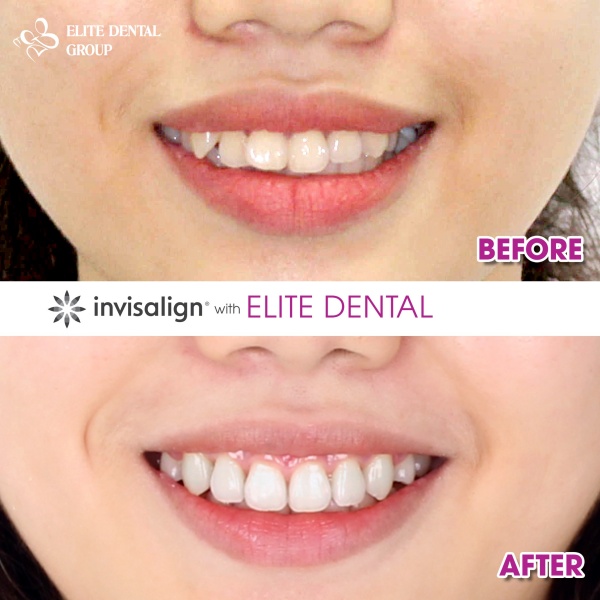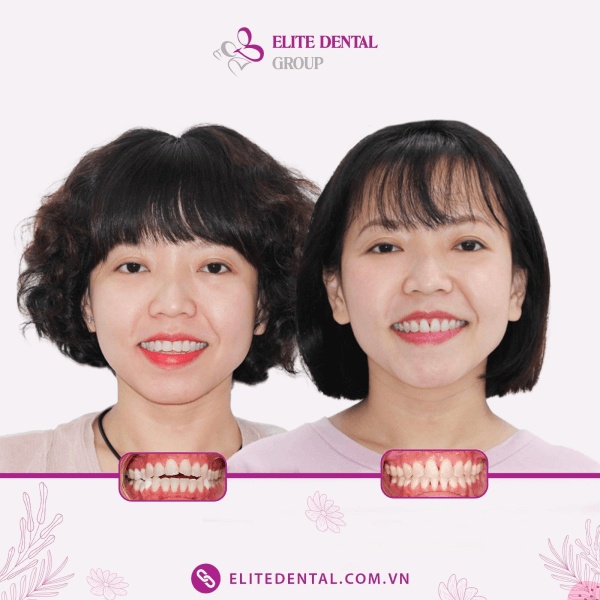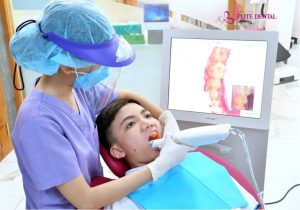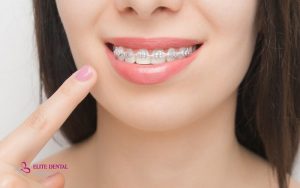Table of content
- 1. Do Braces Change Your Face Shape?
- 2. How Does Your Face Change Before and After Braces?
- 3. How Facial Changes Differ Before and After Braces by Age Group
- 4. Before and After Braces: Transformations by Case Type
- 5. How Improper Orthodontic Treatment Can Affect Your Face
- 6. Before-and-After Results of Orthodontic Cases at Elite Dental
- 7. Frequently Asked Questions About Orthodontics and Facial Changes
Many people who’ve undergone orthodontic treatment notice more than just straighter teeth; braces can actually reshape the face, making it appear slimmer and more defined. But is this truly the case? Today, Elite Dental explores this question in depth.
1. Do Braces Change Your Face Shape?
Braces work by gently moving misaligned teeth into their proper position on the jaw. This not only results in a more even bite and a beautiful smile but can also enhance facial contours, making features appear clearer and more refined.
So, the answer is yes—braces can indeed change your face! However, these changes also depend on your orthodontist’s expertise and the quality of the treatment.
2. How Does Your Face Change Before and After Braces?
After orthodontic treatment, you may notice several key improvements:
2.1. Achieving a More Balanced Face
An uneven bite can make a face appear asymmetrical, which may be less aesthetically pleasing. Braces help align the jaw, balancing facial muscles and creating a more harmonious look.

2.2. Straight, Beautiful Teeth
Having straight, aligned teeth doesn’t just enhance your smile—it transforms your entire appearance. A confident, graceful smile can make a great impression and boost your self-confidence. Aligned teeth are also healthier, with stronger gums and better oral health.
2.3. Slimmer Jawline
In cases where braces correct an underbite, patients often notice a slimmer jawline and more defined facial shape. Realigning the lower jaw or distributing teeth more evenly can result in a slimmer chin or even enhance the V-line of the face.
2.4. Improved Jaw Alignment
Misaligned teeth can affect the relationship between the upper and lower jaws, impacting facial symmetry. With braces, this balance is restored, improving both chewing and facial aesthetics.
2.5. More Defined Facial Features
When teeth are in their proper position, they can subtly affect other features, like giving the appearance of a higher nose bridge, fuller cheekbones, and lips that complement the face better without protruding. This leads to sharper, more defined facial contours.
3. How Facial Changes Differ Before and After Braces by Age Group
Here are the significant changes seen in various orthodontic cases to give you an idea of what to expect:
3.1. Braces for Children
Braces for children are often quicker and easier, especially during the mixed dentition phase (ages 5–12) when the jawbones are still developing. During this stage, orthodontists can guide misaligned teeth into place more effectively, ensuring a proper bite and a balanced, symmetrical face as the child grows.
Starting early (around ages 5–7) with an orthodontic consultation can help detect jaw development issues and treat them in a timely manner for the best outcomes.
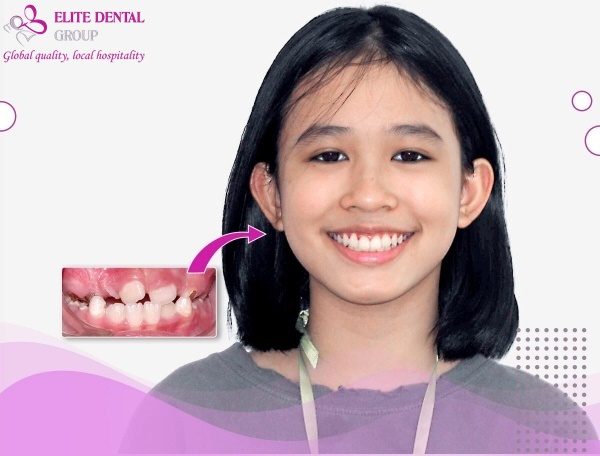
3.2. Braces for Adults
Unlike in children, adult braces take longer since the jaw and teeth have fully matured and are more resistant to movement. However, with a reputable orthodontic provider, experienced specialists, and modern equipment, adult braces can still dramatically improve facial aesthetics, chewing function, and treatment duration.
4. Before and After Braces: Transformations by Case Type
The degree of facial change with braces varies based on each case:
4.1. Overbite Correction
Protruding teeth, often called an overbite, is a type of misalignment where the upper and lower jaws are out of balance. Specifically, the upper jaw extends further forward, causing the chin to look recessed, with a side profile that highlights the protruding upper lip and makes closing the mouth more challenging.
Many people who undergo treatment for protruding teeth experience a remarkable transformation. Braces or orthodontic treatment bring the upper and lower jaws into alignment, arranging the teeth in their proper places. This not only improves the aesthetics of the smile but also enhances the overall facial appearance, giving the nose a more refined look and balancing the profile for a harmonious appearance.

4.2. Underbite Correction
An underbite is a type of reverse bite where the lower jaw extends forward, causing the upper jaw to appear recessed. This makes the lower lip and chin look prominent, and from a side view, the face may appear sunken and imbalanced.
The good news is that with proper orthodontic treatment, the upper jaw can be repositioned forward, and the lower jaw shifted back to align in a natural bite structure. This adjustment refines the face, creating a more harmonious profile with a defined nose-to-lip angle for an overall sharper look.
Many patients who have corrected an underbite with braces report noticeable improvements in chewing and ease of oral care, as a balanced bite makes cleaning teeth more effective.
4.3. Pre- and Post-Treatment Transformation for Crowded, Crooked Teeth
Crowded and crooked teeth refer to misalignments where teeth overlap, twist, or fail to align properly—some receding inwards while others protrude outwards. People experiencing this condition often feel self-conscious about their smile due to its lack of aesthetic appeal, creating an impression of having too many teeth.
Orthodontic treatment for crooked teeth involves using specialized appliances, such as braces (metal brackets and elastics) or clear aligners, to exert force and guide misaligned teeth back to their proper positions. This not only straightens the teeth and creates a balanced bite but also ensures a healthy, natural-looking smile while preserving natural teeth and maintaining optimal chewing function.

4.4. Changes After Treating Gaps Between Teeth
Gapped teeth are a dental issue marked by spaces between teeth that fail to meet, creating visible gaps. These spaces not only affect chewing efficiency and aesthetics but also heighten the risk of dental problems such as enamel erosion and gum disease.
Fortunately, correcting gaps is generally more straightforward compared to other orthodontic issues. Orthodontic treatment can completely eliminate gaps, particularly in the front teeth, resulting in well-aligned, tightly spaced teeth and a more vibrant, confident smile.
4.5. Correcting Open Bite with Orthodontics for Effective Facial Improvement
An open bite occurs when the upper and lower teeth fail to meet, either in the front or back, even when the mouth is fully closed. This can lead to a visibly disproportionate face, flared upper lip, and difficulty in pronouncing certain sounds.
Post-treatment results go beyond closing the bite gap naturally; they also restore balance to the jaw, ensuring a symmetrical alignment of the upper and lower jaws. This improves both chewing efficiency and clarity of speech, especially with sounds requiring tongue articulation or air release.

5. How Improper Orthodontic Treatment Can Affect Your Face
While orthodontics can correct dental and facial irregularities, improper treatment may lead to undesirable effects. Instead of achieving aligned teeth, a balanced bite, and improved facial aesthetics, poor practices can result in:
- Sunken cheeks and temples.
- A shifted midline, leading to an uneven smile.
- Facial asymmetry.
Beyond these cosmetic concerns, improper orthodontics may also cause tooth pain, sensitivity, and soft tissue injuries. [Learn more here!]
6. Before-and-After Results of Orthodontic Cases at Elite Dental
Orthodontics can deliver remarkable transformations, but outcomes depend on the initial dental condition, the chosen method, and the expertise of the dentist.
For those seeking a trusted orthodontic clinic in Ho Chi Minh City, Elite Dental offers a reputable destination. Our clinic is proud to feature a team of seasoned professionals with over a decade of experience handling even the most complex orthodontic cases.
We also focus on creating a calming treatment environment, ensuring patients feel relaxed and at ease. Equipped with state-of-the-art technology like the 3D Trios Scanner, ClinCheck software, and Sinora X-ray machines, we help reduce discomfort and expedite treatment timelines.
At Elite Dental, we maintain a comprehensive database of successful cases. During consultations, patients can review real-life results to gain confidence in their treatment journey and visualize potential outcomes.
Notable Cases of Facial Transformations at Elite Dental
Protrusion Correction:
- Case of Thai Phuong Lien: Her narrow upper jaw and inability to close her lips were resolved early through a precise orthodontic plan and dedicated monitoring by Elite Dental specialists.

- Thanh Thao’s Transformation: After treatment, Thanh Thao’s face underwent significant positive changes, eliminating her protrusion and achieving a harmonious smile with a graceful profile.

Open Bite Treatment:
- Thanh Vy’s Journey: Thanh Vy noticed significant improvements in her facial aesthetics, including enhanced nasal structure, after her orthodontic journey to close bite gaps and reduce protrusion at Elite Dental.

Deep Bite Treatment:
- Many parents commend Elite Dental for delivering impressive results, giving children beautifully aligned teeth and properly balanced bites.

Facial Improvement with Orthodontics:
- Tri Le’s Story: “Post-treatment, I feel exceptionally confident with my straight, beautiful teeth. I’m extremely satisfied with my choice to trust Elite Dental.”
Reverse Bite Resolution:
- Dao Nguyen’s Testimony: “With my perfect new smile, I feel completely confident in social interactions. My improved jaw alignment also lets me chew evenly, unlike before.”
- Dao Nguyen, who had severe skeletal issues, experienced dramatic improvements in her facial profile post-treatment. Follow-up care ensures her progress remains stable into adulthood.
7. Frequently Asked Questions About Orthodontics and Facial Changes
At Elite Dental, our specialists address some of the most common concerns about how orthodontic treatment can transform facial appearance:
7.1. Does Orthodontic Treatment Make Your Nose Look Higher?
Successful orthodontic treatment can retract the upper lip, which, in turn, highlights the bridge of the nose. This creates the illusion of a slimmer, more defined, and slightly elevated nose compared to before the treatment.
7.2. Can Orthodontics Alter Your Facial Profile?
Yes, orthodontics is a highly effective way to improve the facial profile. By adjusting elements such as the nose, lips, and chin, it enhances the side profile, giving it a more refined and harmonious appearance, whether smiling or at rest.
At Elite Dental, we’ve observed many cases where patients initially had pronounced protrusions or unbalanced profiles. After orthodontic treatment, their faces became more symmetrical and naturally appealing, with no trace of their former protrusions.
7.3. Can Orthodontics Fix Facial Asymmetry?
If facial asymmetry is caused by misaligned bites, orthodontics can effectively correct it by aligning the bite to its proper position. This adjustment balances the overall facial structure, restoring symmetry and enhancing the face’s natural beauty.
7.4. Does Orthodontic Treatment Cause Higher Cheekbones?
The perception of higher cheekbones often stems from sunken cheeks, which make the cheekbones appear more prominent. However, orthodontic treatment does not directly cause hollow cheeks or elevated cheekbones. These issues are often linked to factors such as unilateral chewing habits, lifestyle choices (e.g., resting on one side), or untreated tooth loss over an extended period.
In summary, orthodontics can significantly enhance facial aesthetics when performed by experienced professionals using precise techniques. However, to ensure optimal and lasting results, it’s crucial to adopt healthy lifestyle habits and seek early intervention if you notice abnormalities in tooth or bite alignment.



